Liquidity Flywheel Drives Binance to 300 Million Users

ETH Markets Lag BTC Ahead of Upgrade

Welcome to the Data Debrief!
-
ETH’s falling market share relative to BTC
-
Massive altcoin trade volume on Korean exchanges
-
SushiSwap’s major struggles attracting liquidity
Trend of the Week
ETH markets lag BTC ahead of Shapella upgrade.
This week, the most important upgrade to the Ethereum network since the Merge will likely be completed. The Shapella upgrade [Shanghai + Capella] will allow staked ETH (which now numbers more than 18mn) to be withdrawn over time. This has raised some big questions: Will large stakers dump their newly unlocked tokens? Will this create more confidence in staking and thus increase participation?
Uncertainty around the upgrade has fed volatility and had a moderate impact on derivatives markets, with ETH open interest increasing by $400mn since the start of April. However, BTC continues to dominate market headlines, with open interest rising faster than ETH yesterday as prices hit their highest level since June 2022.
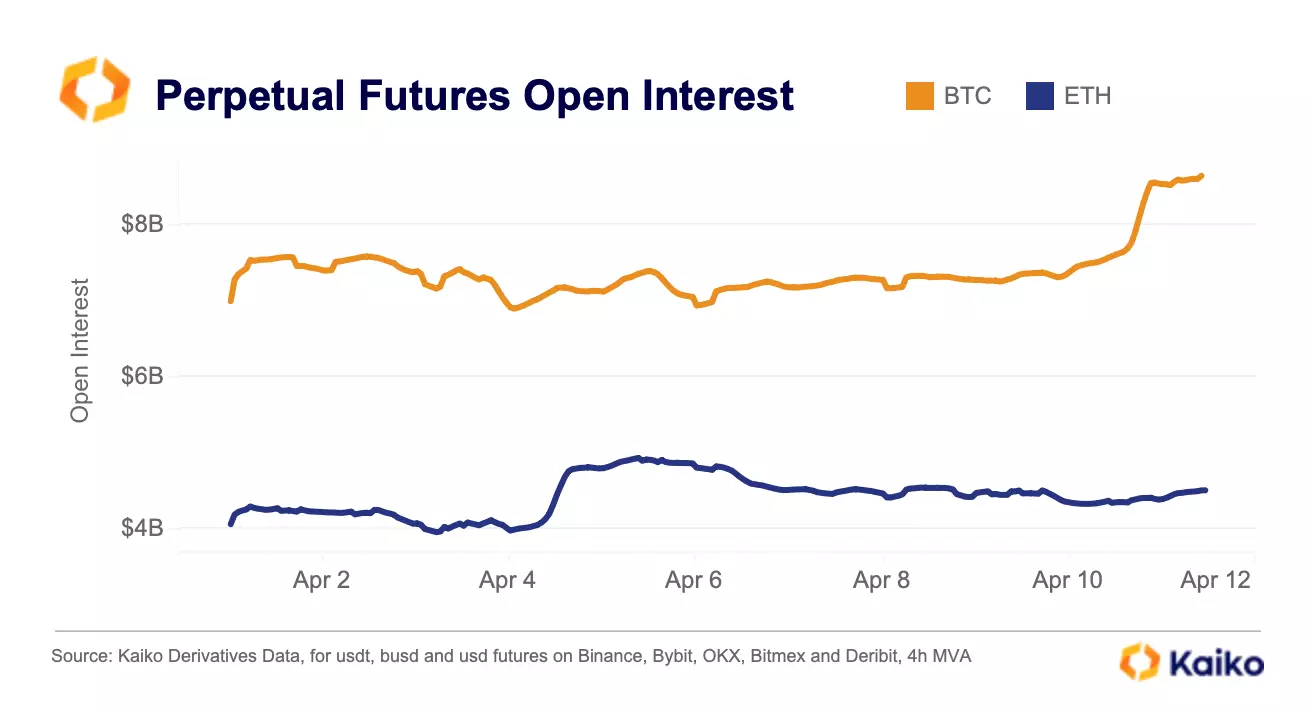
Overall, ETH markets have been heavily spot-driven over the past month, as measured by the perpetual futures to spot ratio, which hit its lowest level since the Merge. This is an interesting turnaround, especially considering the ratio had surged to nearly double pre-Merge levels at the start of the year amid a broad crypto rally. The ratio has been on a consistent downtrend since late February as the banking crisis and BTC rally continue to dominate market movements.
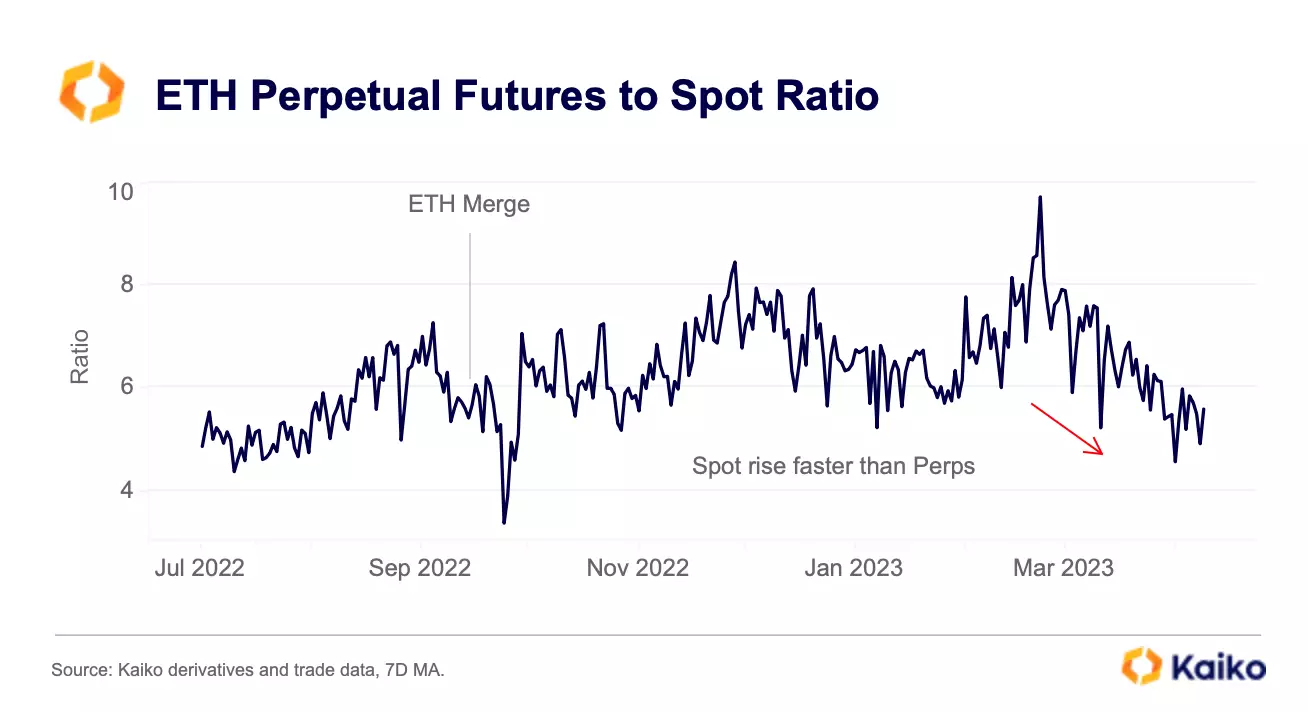
ETH’s spot volumes have struggled to maintain pace with BTC’s, with ETH’s market share of USD volume recently hitting its lowest levels since March 2021. We look only at USD pairs to avoid the impact of Binance’s zero-fee BTC trading promotion, which caused global BTC volumes to surge relative to all other cryptocurrencies without any catalysts.
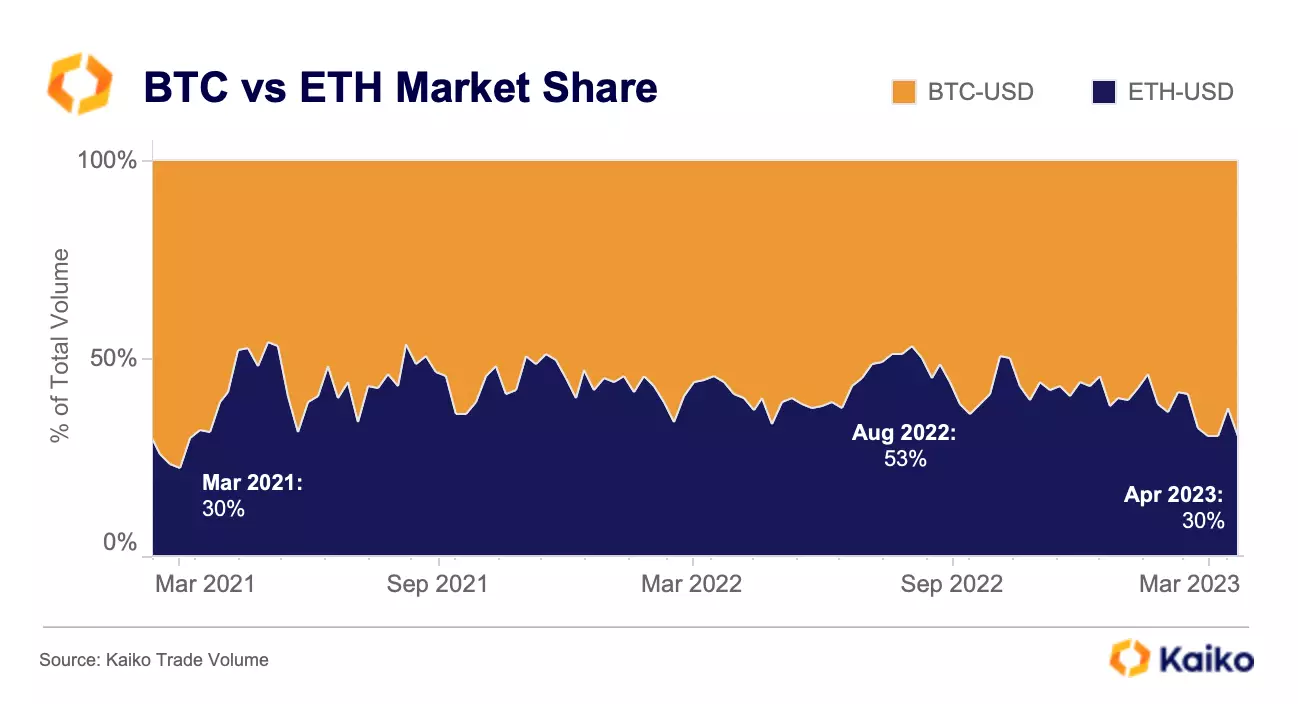
As of last week, ETH spot volumes relative to BTC were jut 30%. The last time spot market share was this low was March 2021. Right before the Merge in August 2022, spot volumes hit an all time high at 53% market share.
While spot and derivatives are lagging BTC, ETH options markets are reflecting the uncertainty around the upgrade.
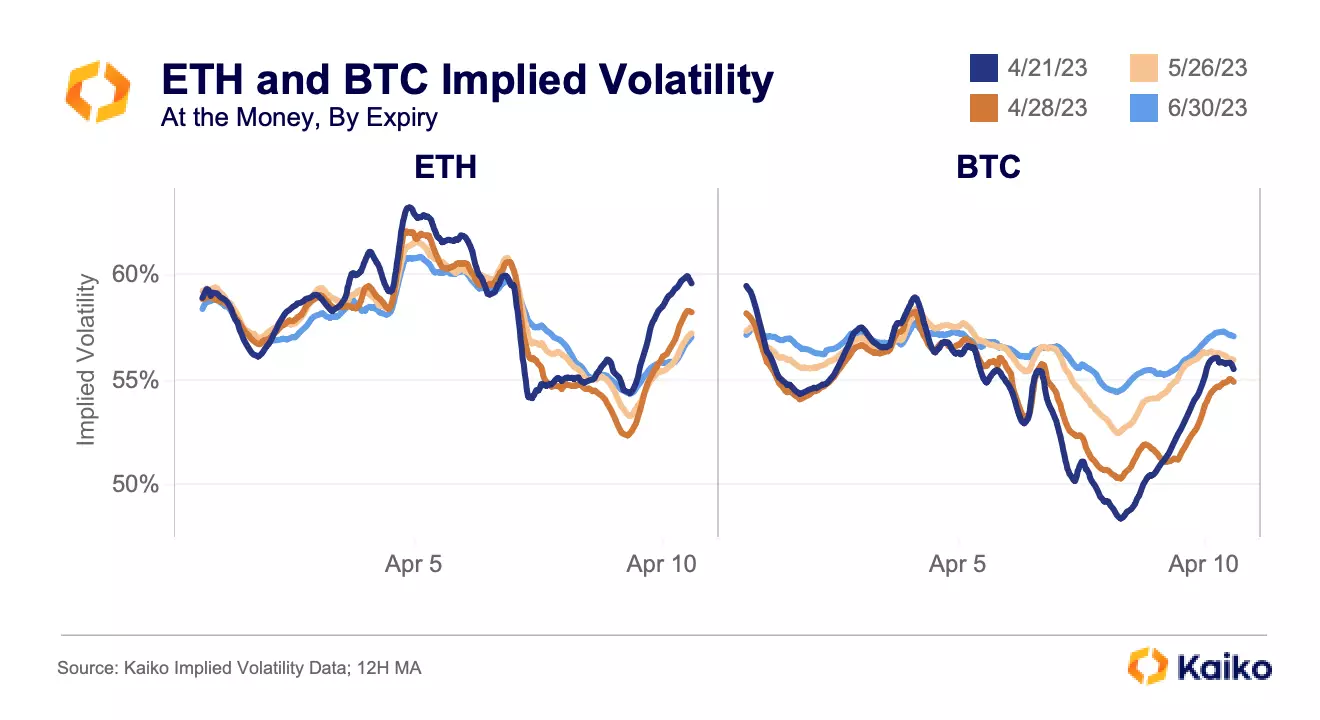
ETH’s implied volatility – particularly for April expiries – has been higher than BTC’s at nearly every point over the past week. Set next to BTC, it’s clear how different ETH’s volatility structure has become ahead of the upgrade. The nearest expiry for ETH has generally had the highest IV of any expiry, while BTC has shown the opposite, with longer term expiries pricing in more volatility.
Additionally, all ETH expiries have moved closely with one another while the longer BTC expiries have remained stable, again indicating that there is more uncertainty – particularly in the long term – in ETH derivatives markets.

Join the Kaiko Research team for our next monthly analyst call, discussing the most significant market trends.
Price
LQTY remains a top performer in wake of USDC depeg.
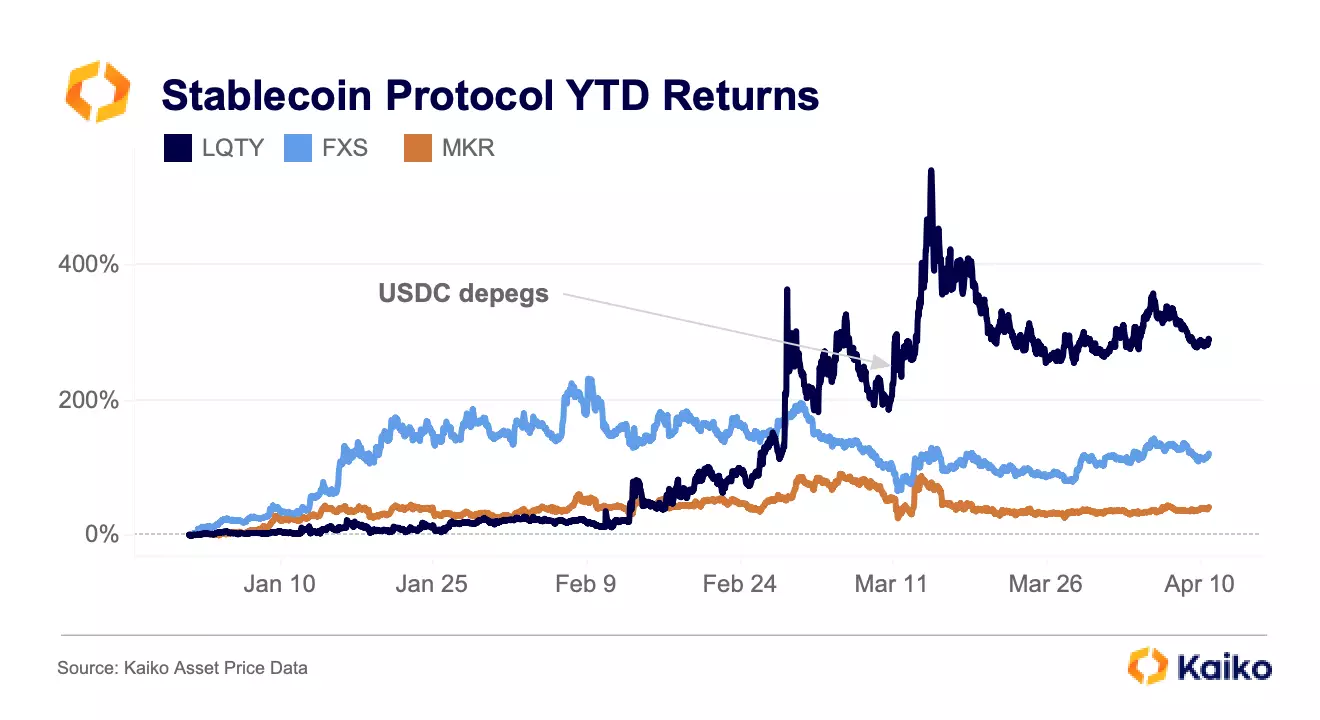
LQTY, the token for the stablecoin protocol Liquity, has been a top performer this year, with its rallies sparked by troubles facing other stablecoins, namely BUSD and USDC. The token first surged in late February as Paxos announced that it would cease issuing BUSD, then again following USDC’s depegging. Liquity’s stablecoin LUSD can only be minted using ETH, meaning it was not exposed to the depegging, whereas FRAX and DAI both depegged alongside USDC because the stablecoin is a large part of their backing. The tokens associated with FRAX and DAI, FXS and MKR, have also registered gains this year despite their associated stablecoins depegging, with MKR up 40% and FXS up 120%.

Never miss an analysis.
Subscribe to our free weekly Data Debrief email, or learn more about our premium research subscriptions here.
Liquidity
95% of volume on Korean exchanges is for altcoins.
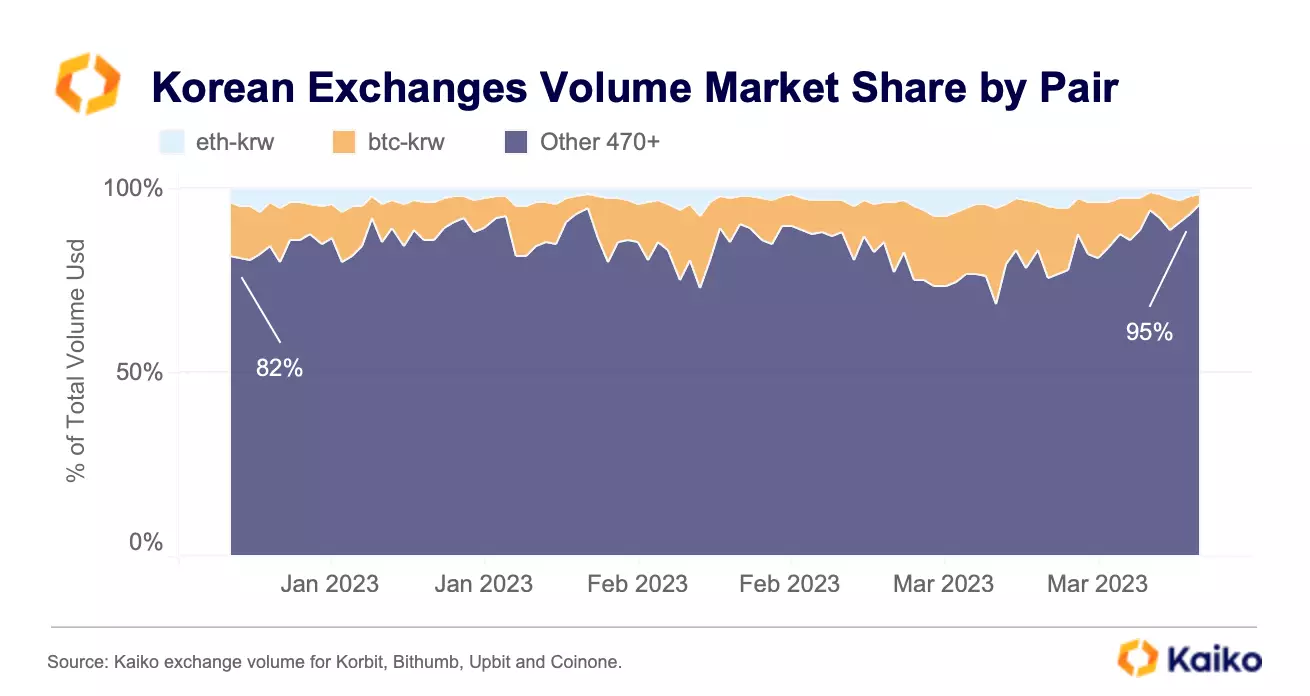
Last week, trade volumes on the Big 4 Korean exchanges — Upbit, Bithumb, Korbit and Coinone — hit its highest level this year, exceeding $4bn for the first time since February. The increase was driven by altcoins, whose market share rose to a multi-year high of 95%. While the share of altcoins on Korean markets oscillated significantly this year from around 82% in January to a ten-month low of 68% in mid-March, it remains significantly higher relative to other exchanges.
Over the past two years altcoins accounted for over 80% of all trade volumes on these exchanges. On most non-Korean exchanges, BTC and ETH account for between ~40/50% of trade volume. Korean exchanges thus represent highly anomalous market structure, serving as the primary venues for many small and illiquid altcoins, far surpassing Binance in terms of volumes for certain tokens. Stringent regulation in Korea also makes price arbitrage difficult, creating price discrepancies.
SushiSwap volumes continues to struggle.
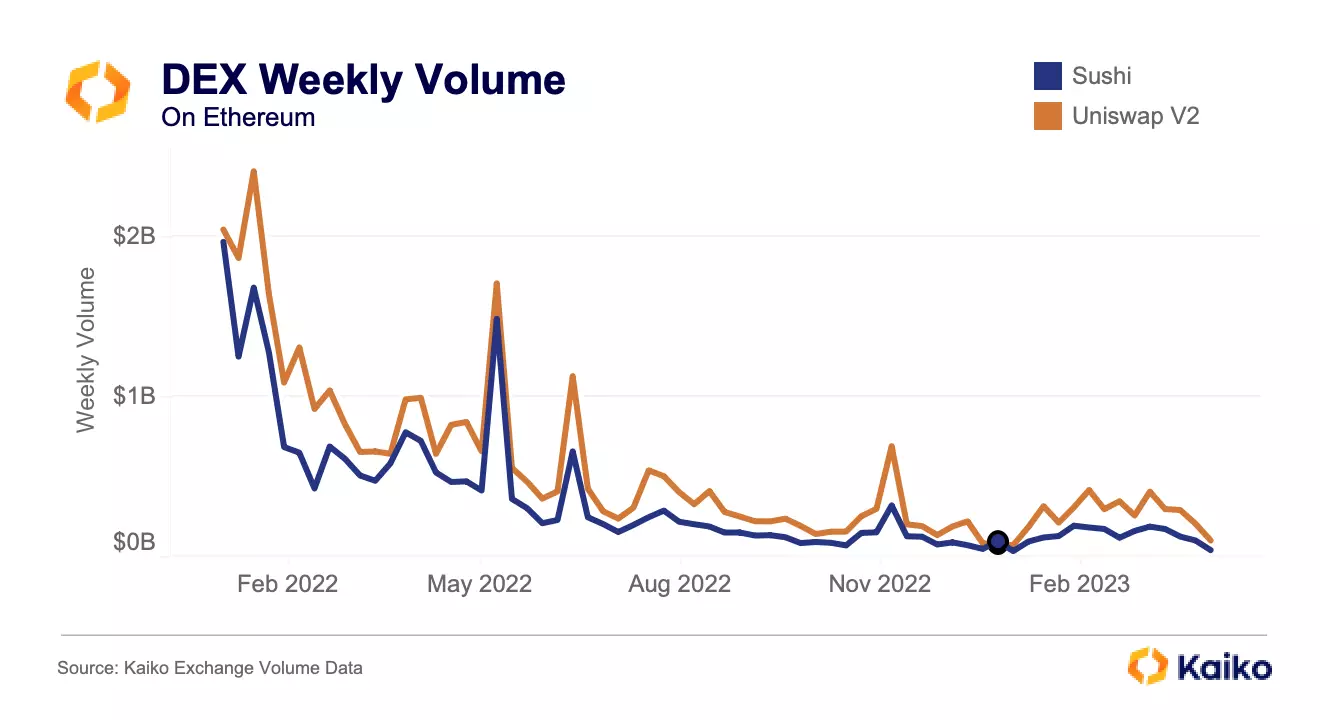
In the last 66 weeks, Sushi has only registered more weekly volume than Uniswap V2 once: the week of Christmas, when it did $100mn in volume compared to Uniswap V2’s $81mn. This fact somehow understates Sushi’s troubles, as it has been unable to compete with V2, let alone Uniswap V3, which has registered over $4bn weekly volume in all but 8 of its 101 weeks of existence.
The DEX’s struggles were further exacerbated when the SEC served Sushi’s Head Chef with a subpoena. Then, this weekend over $3mn was stolen from users on the protocol. In its latest attempt to attract volume, Sushi forked Uniswap V3’s code, which became open source at the beginning of the month.
Liquid staking token liquidity triples ahead of Shanghai.
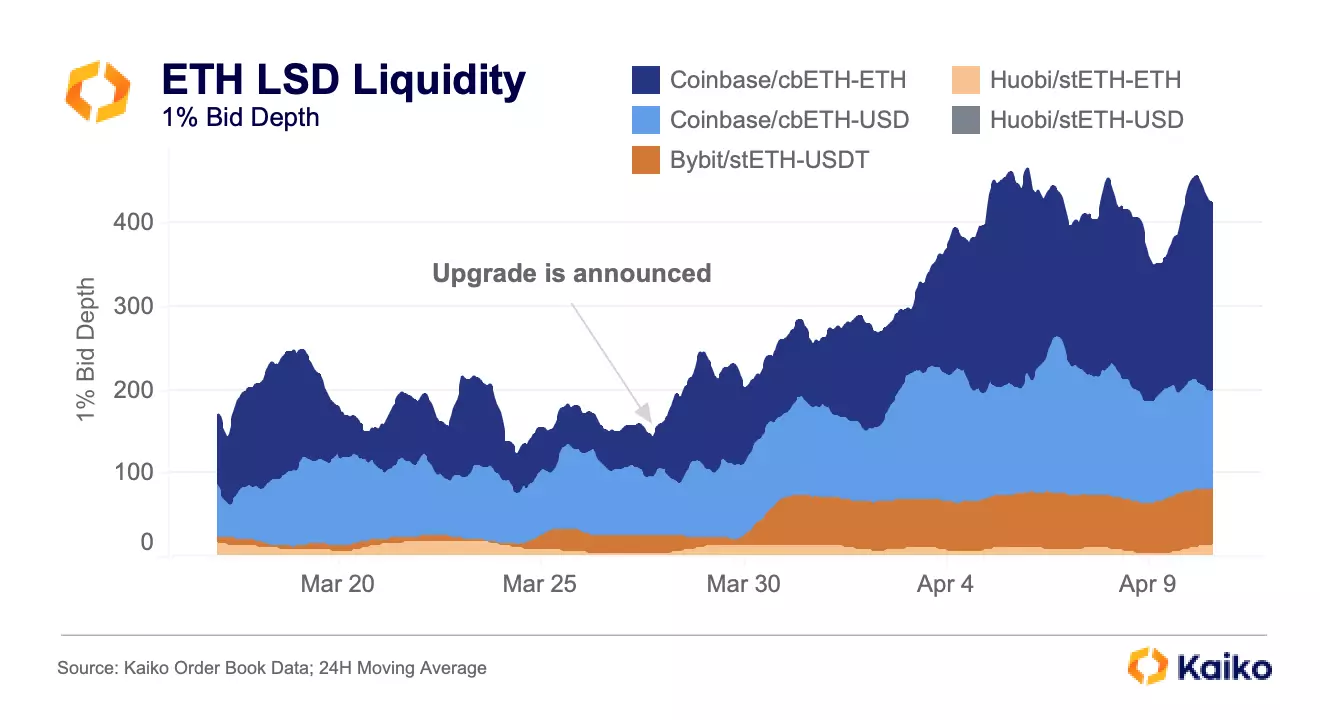
While the majority of ETH liquid staking derivatives (LSD) trading takes place on DEXs, liquidity on centralized exchanges has improved substantially since the Shapella upgrade was announced. At that time, there was less than 150 cbETH worth of bids within 1% of the mid price on Coinbase; Bybit and Huobi together had just 25 stETH worth. Since the announcement bid depth has surged, led by Coinbase’s cbETH-ETH pair, which has become more than four times deeper while the cbETH-USD pair doubled.
stETH pairs still remain very illiquid compared to the token’s supply, with the Bybit stETH-USDT pair’s 1% bid depth at 65 stETH and Huobi at just 15 stETH. Again, most trading of ETH LSDs takes place on DEXs, but it will be important to monitor how these tokens’ liquidity fares once withdrawals are enabled.
New DeFi Coverage
Now Live
We are proud to have expanded our DeFi coverage with the launch of Curve v2, Maker, and Balancer v2. Kaiko’s DeFi data allows clients to visualize swaps, mints, burns, and more for the top decentralized protocols. Now covering:
-
Curve v2: trading, and liquidity data for uncorrelated assets
-
Maker: L&B activity + real-world asset events data
-
Balancer v2: trading and liquidity data in smart pools
Derivatives
DOGE OI hit yearly high after meme replaced Twitter logo.
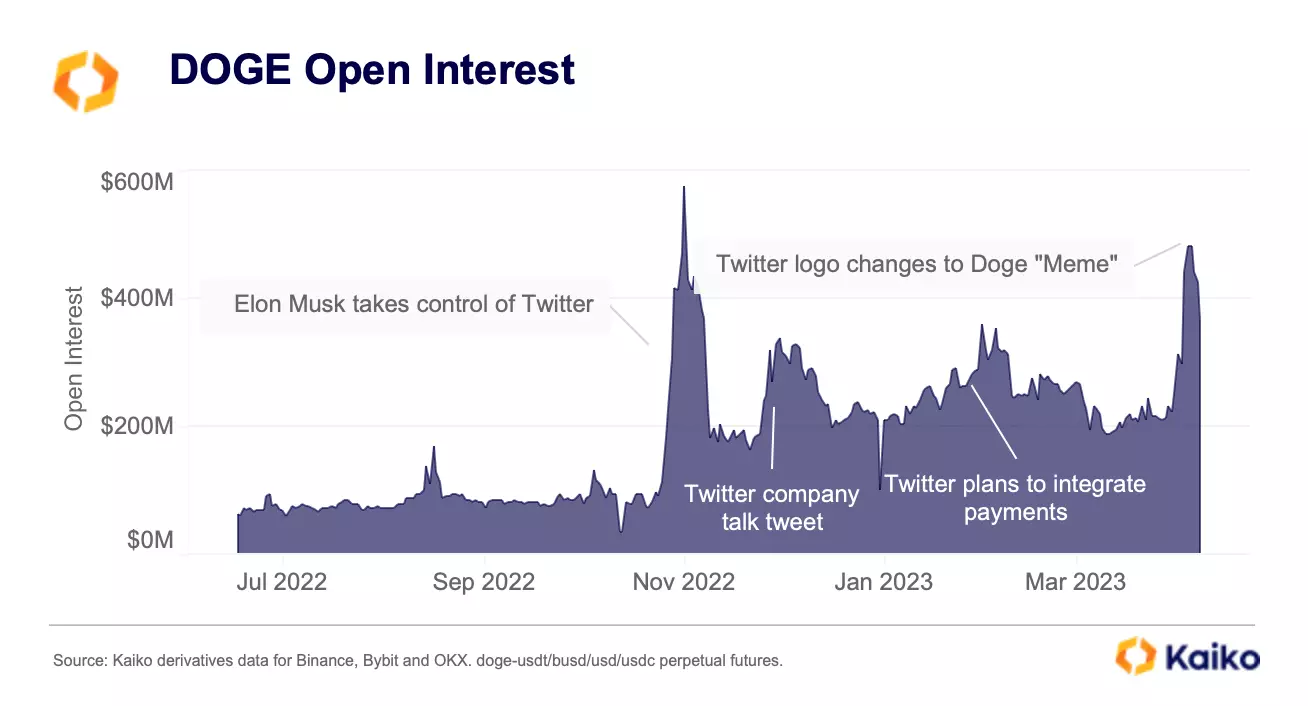
DOGE open interest and spot prices exhibited strong volatility in April, hitting multi-month highs before retreating after Twitter briefly changed its logo to the famous “doge” between April 4-7. While the reasons for the change are unclear, DOGE prices rallied by over 30% in less than 24 hours. Open interest also more than doubled from $210mn at the end of March to $480mn before declining to $360mn following a wave of liquidations.
Overall, despite bouts of volatility DOGE open interest has roughly doubled since Elon Musk took over Twitter last year, suggesting robust capital inflows. Twitter announced in January that it is moving forward with plans to introduce a payments feature, opening the way for more use cases for the token. For now, despite no real use cases, The memecoin currently ranks 8th in terms of market cap.
Derivatives volume is skewed towards U.S. hours.
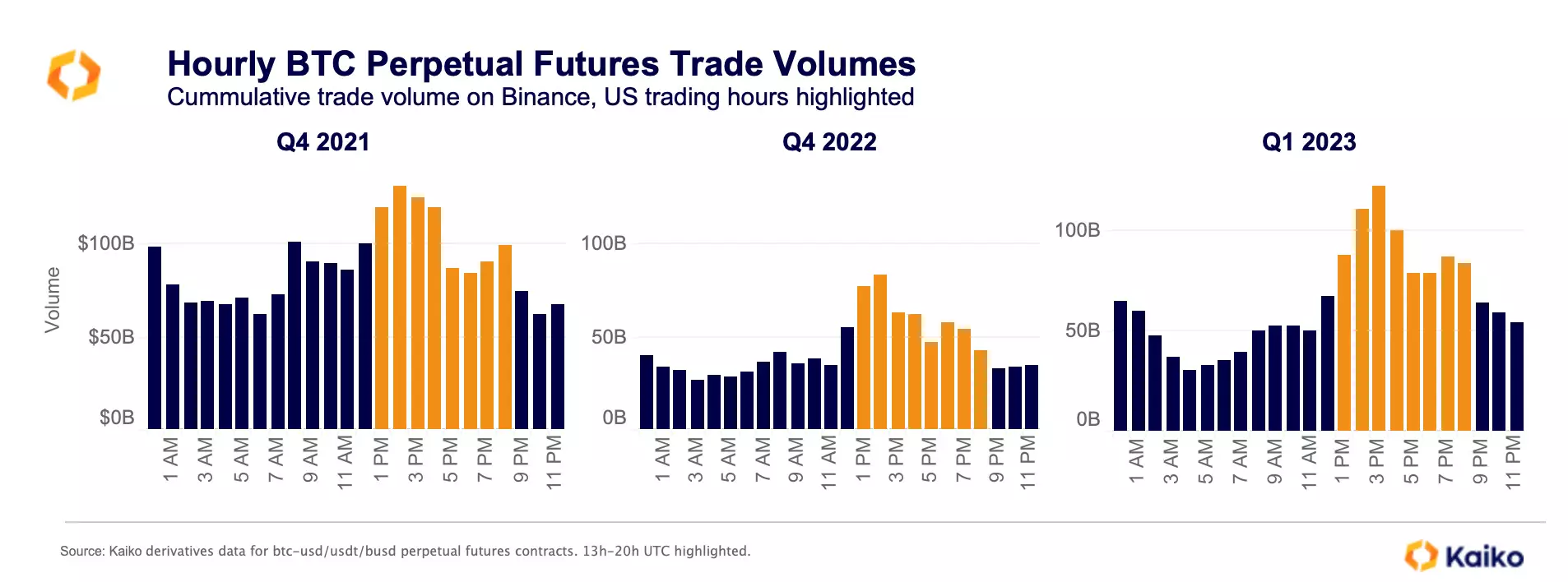
BTC perpetual futures trade volume on Binance is skewed towards U.S. trading hours. This trend has accelerated over the past two years. In Q1 2023, the share of perpetual futures traded between 1pm and 8pm UTC (9am-4pm ET) has increased to 48% from 46% in Q4 2022 and 40% in Q4 2021. This is largely due to a slower decline in trading during U.S. trading hours, which dropped by 13% in Q1 2023 relative to 2021 compared to a 37% decline for non-U.S. hour volumes.
However, we have noticed a clear decline in trading during U.S. hours in the two weeks since the CFTC lawsuit. Among other allegations, the CFTC claimed that Binance was targeting U.S. institutions to trade on its international platform.
Macro
Bitcoin shows resilience to tightening macro liquidity.
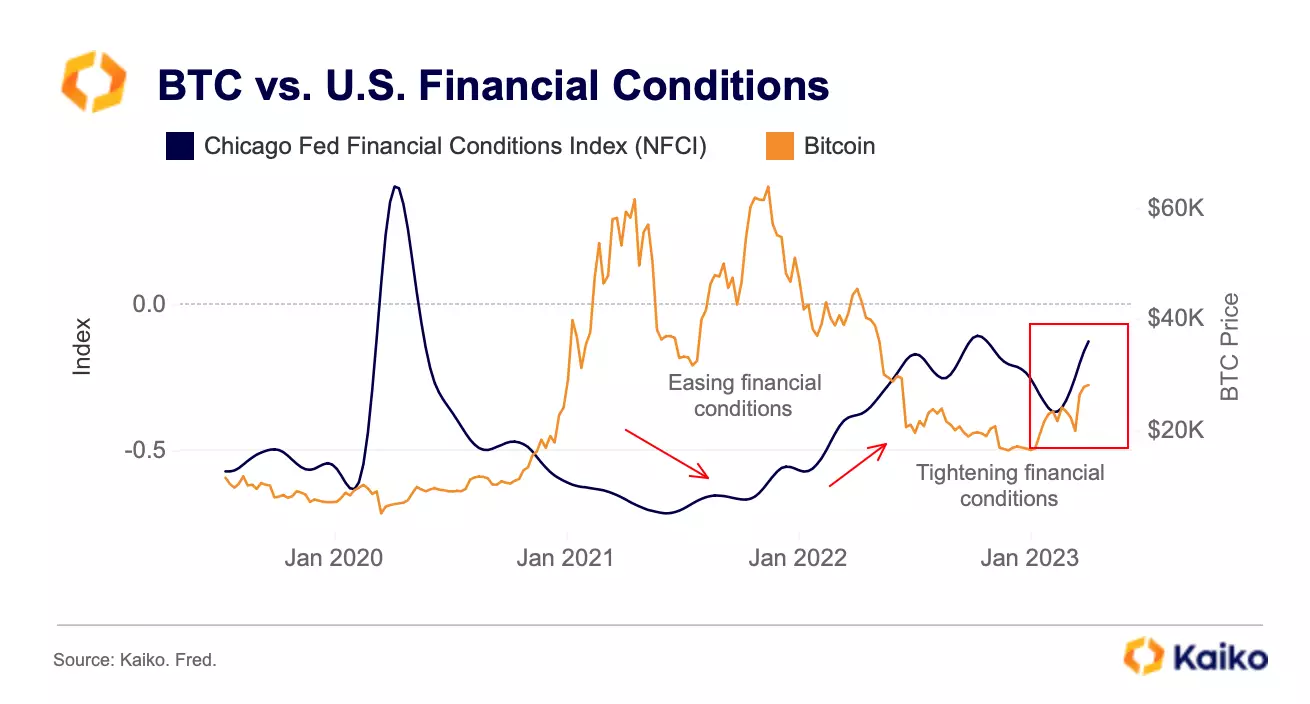
Historically, BTC has shown a negative correlation with the Chicago Fed National Financial Index (NFCI), which is a gauge of financial conditions in the U.S. Rising NFCI typically indicates declining liquidity and leverage along with higher volatility and risk premia. Thus, BTC tends to rise when financial conditions ease and fall when they tighten. However, despite the significant tightening of financial conditions, BTC has weathered the banking turmoil well, rising by over 44% since the collapse of SVB on March 10.
Tokenized gold reaches new high.
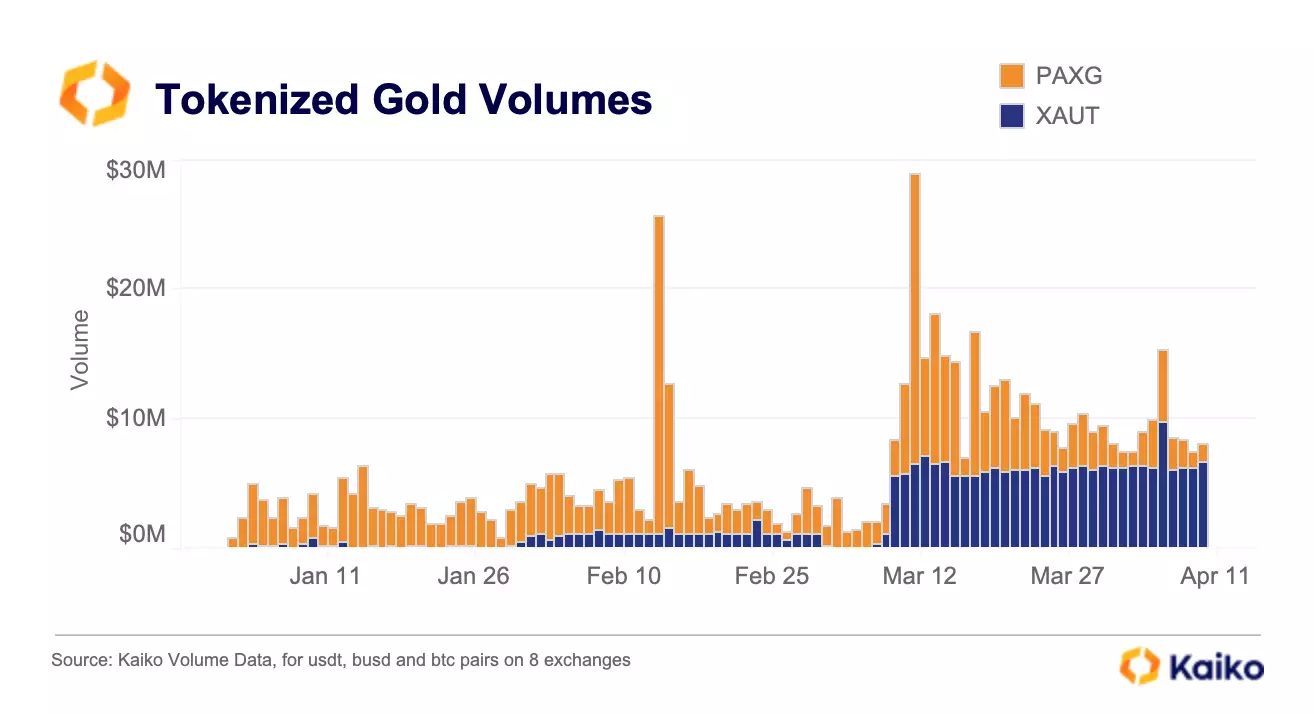
Last week, tokenized gold assets surpassed $1bn in combined market cap. Tokenised gold offers an alternative method to owning gold, allowing investors to avoid the gold ETF fees, which has been one of the most popular ways to invest in gold in recent years. The two largest gold stablecoins, pegged to the price of gold, are Tether Gold (XAUT) and Paxos Gold (PAXG). XAUT charges a 0.25% fee for creation and redemption of tokens while PAXG charges a 0.02% on-chain transaction fee.
Volumes have increased recently, with Tether Gold commanding the majority of volumes, bucking the previous dominance of Pax Gold. Tether Gold jumped from just a 1% market share of volumes to 85% of volumes last week in what looks to be methodical transactions.
Data Used in this Analysis

More From Kaiko Research
![]()
Derivatives
22/12/2025 Data Debrief
Crypto in 2026, What Breaks, What Scales, What ConsolidatesCrypto markets enter 2026 in a markedly different position than in prior cycle transitions. Rather than resetting after a speculative peak, the market appears to be progressing through a phase of institutional consolidation.
Written by Thomas Probst![]()
Year in Review
01/12/2025 Data Debrief
Kaiko Research's Top 10 Charts of 2025In this report, we look back on 2025 and the key forces that shaped markets. From BTC record highs and fleeting altcoin rallies to major liquidation events and evolving regulation, we examine what shaped a seminal year for crypto.Written by Adam Morgan McCarthy![]()
Stablecoin
24/11/2025 Data Debrief
MiCA's Impact on Crypto in EuropeEurope is progressing with a conservative structured crypto framework that leans towards regulating innovation.Written by Adam Morgan McCarthy![]()
Macro
17/11/2025 Data Debrief
Navigating Fed Fears & AI Bubble BurstingGiven the current macroeconomic context, we are seeing the emergence of two major risks likely to have a decisive impact.
Written by Adam Morgan McCarthy








